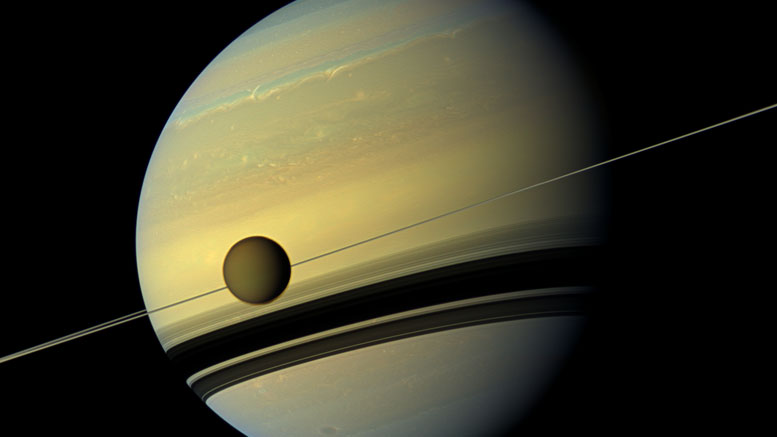
New research from NASA reveals the chemical acrylonitrile in the atmosphere of Saturn’s moon Titan, a place that has long intrigued scientists investigating the chemical precursors of life.
On Earth, acrylonitrile, also known as vinyl cyanide, is useful in the manufacture of plastics. Under the harsh conditions of Saturn’s largest moon, this chemical is thought to be capable of forming stable, flexible structures similar to cell membranes. Other researchers have previously suggested that acrylonitrile is an ingredient of Titan’s atmosphere, but they did not report an unambiguous detection of the chemical in the smorgasbord of organic, or carbon-rich, molecules found there.
Now, NASA researchers have identified the chemical fingerprint of acrylonitrile in Titan data collected by the Atacama Large Millimeter/submillimeter Array (ALMA) in Chile. The team found large quantities of the chemical on Titan, most likely in the stratosphere — the hazy part of the atmosphere that gives this moon its brownish-orange color.
The researchers calculated how much material could be deposited in Ligeia Mare, Titan’s second-largest lake, which occupies roughly the same surface area as Earth’s Lake Huron and Lake Michigan together. Over the lifetime of Titan, the team estimated, Ligeia Mare could have accumulated enough acrylonitrile to form about 10 million azotosomes in every milliliter, or quarter-teaspoon, of liquid. That’s compared to roughly a million bacteria per milliliter of coastal ocean water on Earth.
The key to detecting Titan’s acrylonitrile was to combine 11 high-resolution data sets from ALMA. The team retrieved them from an archive of observations originally intended to calibrate the amount of light being received by the telescope array.
Source: https://www.nasa.gov/feature/goddard/2017/nasa-finds-moon-of-saturn-has-chemical-that-could-form-membranes/
On Earth, acrylonitrile, also known as vinyl cyanide, is useful in the manufacture of plastics. Under the harsh conditions of Saturn’s largest moon, this chemical is thought to be capable of forming stable, flexible structures similar to cell membranes. Other researchers have previously suggested that acrylonitrile is an ingredient of Titan’s atmosphere, but they did not report an unambiguous detection of the chemical in the smorgasbord of organic, or carbon-rich, molecules found there.
Now, NASA researchers have identified the chemical fingerprint of acrylonitrile in Titan data collected by the Atacama Large Millimeter/submillimeter Array (ALMA) in Chile. The team found large quantities of the chemical on Titan, most likely in the stratosphere — the hazy part of the atmosphere that gives this moon its brownish-orange color.
The researchers calculated how much material could be deposited in Ligeia Mare, Titan’s second-largest lake, which occupies roughly the same surface area as Earth’s Lake Huron and Lake Michigan together. Over the lifetime of Titan, the team estimated, Ligeia Mare could have accumulated enough acrylonitrile to form about 10 million azotosomes in every milliliter, or quarter-teaspoon, of liquid. That’s compared to roughly a million bacteria per milliliter of coastal ocean water on Earth.
The key to detecting Titan’s acrylonitrile was to combine 11 high-resolution data sets from ALMA. The team retrieved them from an archive of observations originally intended to calibrate the amount of light being received by the telescope array.
Source: https://www.nasa.gov/feature/goddard/2017/nasa-finds-moon-of-saturn-has-chemical-that-could-form-membranes/
Comments
Post a Comment